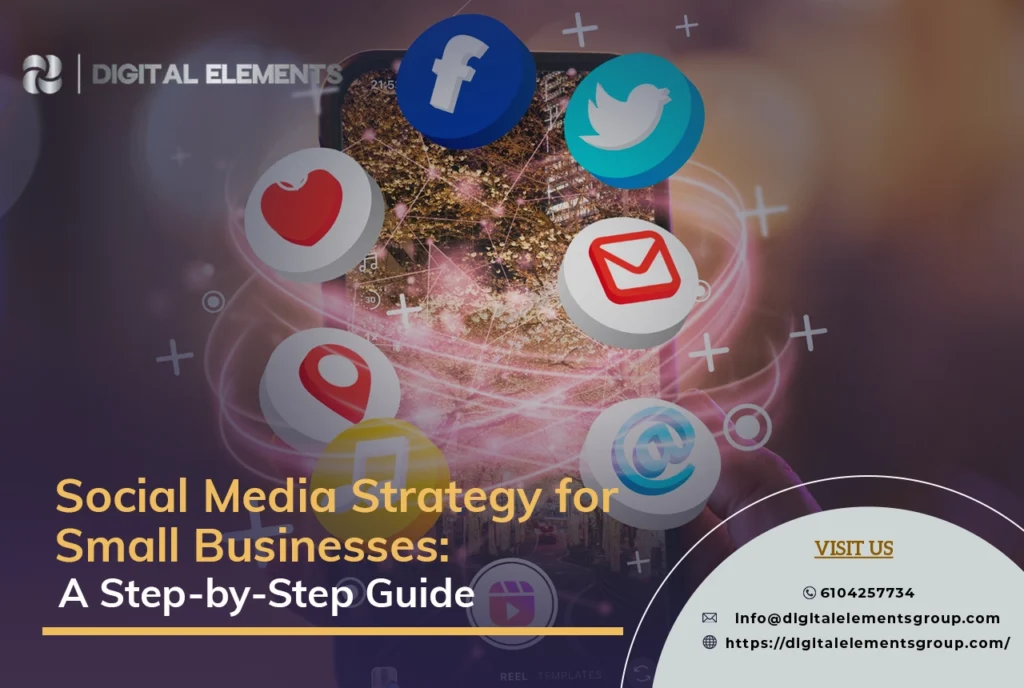Introduction
In today’s digital age, social media is a powerful tool for small businesses to connect with their audience, build brand awareness, and drive sales. However, simply being active on social media isn’t enough. To maximize your impact, you need a well-planned strategy. This step-by-step guide will help you create an effective social media strategy tailored to your business goals.

Step 1: Define Your Goals
Before diving into social media marketing, identify what you want to achieve. Your goals should be SMART (Specific, Measurable, Achievable, Relevant, and Time-bound). Some common social media goals for small businesses include:
- Increasing brand awareness
- Driving website traffic
- Generating leads and sales
- Engaging with customers
- Growing a loyal community
Step 2: Know Your Target Audience
Understanding your audience is key to crafting relevant content and selecting the right platforms. Research your audience based on:
- Demographics: Age, gender, location, income, etc.
- Psychographics: Interests, hobbies, values, and behaviors.
- Social Media Preferences: Which platforms they use and how they engage with content.
Use tools like Google Analytics, Facebook Insights, and surveys to gather this data.
Step 3: Choose the Right Social Media Platforms
Not all social media platforms are suitable for every business. Choose platforms where your audience is most active:
- Facebook: Best for community building and advertising.
- Instagram: Great for visual storytelling and brand aesthetics.
- Twitter (X): Ideal for real-time engagement and customer service.
- LinkedIn: Best for B2B businesses and professional networking.
- Pinterest: Useful for businesses in fashion, home decor, and lifestyle.
- TikTok: Great for creative, short-form video content.
Step 4: Develop a Content Strategy
Content is the backbone of social media marketing. Your content should be engaging, valuable, and aligned with your brand’s voice. Follow the 80/20 rule:
- 80% value-driven content: Educational, entertaining, and inspiring posts.
- 20% promotional content: Advertisements, product promotions, and offers.
Types of content to consider:
- Blog posts and articles
- Infographics
- Videos and reels
- Customer testimonials and reviews
- Polls and interactive content
- Behind-the-scenes posts
Step 5: Create a Content Calendar
A content calendar helps you stay consistent and organized. Plan posts in advance to maintain a regular posting schedule. Use tools like Trello, Hootsuite, or Buffer to schedule and automate your posts.
A basic posting frequency guide:
- Facebook & Instagram: 3-5 times per week
- Twitter (X): Multiple times a day
- LinkedIn: 2-3 times per week
- Pinterest: 5-10 pins per day
- TikTok: 3-5 times per week
Step 6: Engage With Your Audience
Social media isn’t just about posting content—it’s about interaction. Engage with your audience by:
- Responding to comments and messages promptly.
- Liking and sharing user-generated content.
- Hosting Q&A sessions and live streams.
- Running contests and giveaways.
- Asking questions and encouraging discussions.
Step 7: Use Hashtags and Keywords
Hashtags and keywords help improve your reach and visibility. Research trending hashtags relevant to your industry and mix them with branded hashtags. For example:
- General hashtags: #SmallBusiness, #MarketingTips, #SocialMedia
- Industry-specific hashtags: #FoodBusiness, #TechStartup, #FitnessMarketing
Step 8: Invest in Paid Advertising
Organic reach is declining, and investing in paid social media ads can help you reach a broader audience. Platforms like Facebook, Instagram, and LinkedIn offer targeted advertising options based on:
- Location
- Interests
- Behavior
- Demographics
Types of paid ads:
- Boosted posts
- Carousel ads
- Video ads
- Lead generation ads
Step 9: Analyze and Optimize Performance
Regularly track and analyze your social media performance using insights and analytics tools. Key metrics to monitor include:
- Engagement rate (likes, comments, shares)
- Click-through rate (CTR)
- Conversion rate
- Follower growth
- Website traffic from social media
Use these insights to refine your strategy and improve your content.
Step 10: Stay Updated With Trends
Social media trends evolve constantly. Stay ahead by:
- Following industry leaders and influencers.
- Testing new content formats (e.g., short videos, reels, interactive polls).
- Adapting to algorithm changes on different platforms.
A strong social media strategy can transform your small business, helping you connect with your audience and grow your brand. By following these steps—setting goals, understanding your audience, creating quality content, engaging actively, and tracking performance—you can build an effective and sustainable social media presence.
Start implementing your strategy today and watch your business thrive online!



